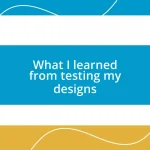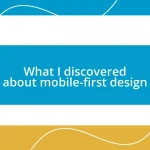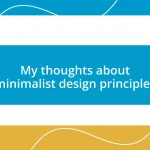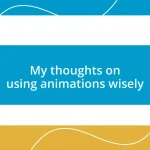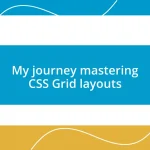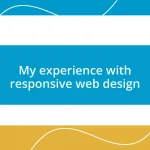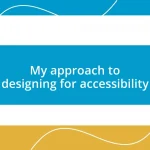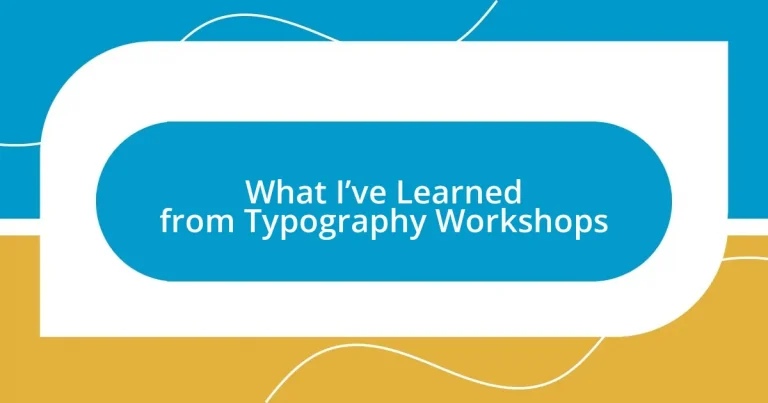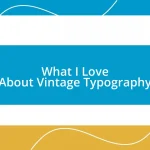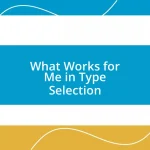Key takeaways:
- Typography’s anatomy, such as kerning and font weight, significantly affects readability and emotional perception.
- Creating contrast, using grids, and maintaining consistency in typography enhance design clarity and brand identity.
- Choosing the right fonts according to context and limiting selections to a few complementary options results in stronger designs.
- Avoid common mistakes like poor spacing, overusing decorative fonts, and inadequate color contrast to improve legibility and audience engagement.
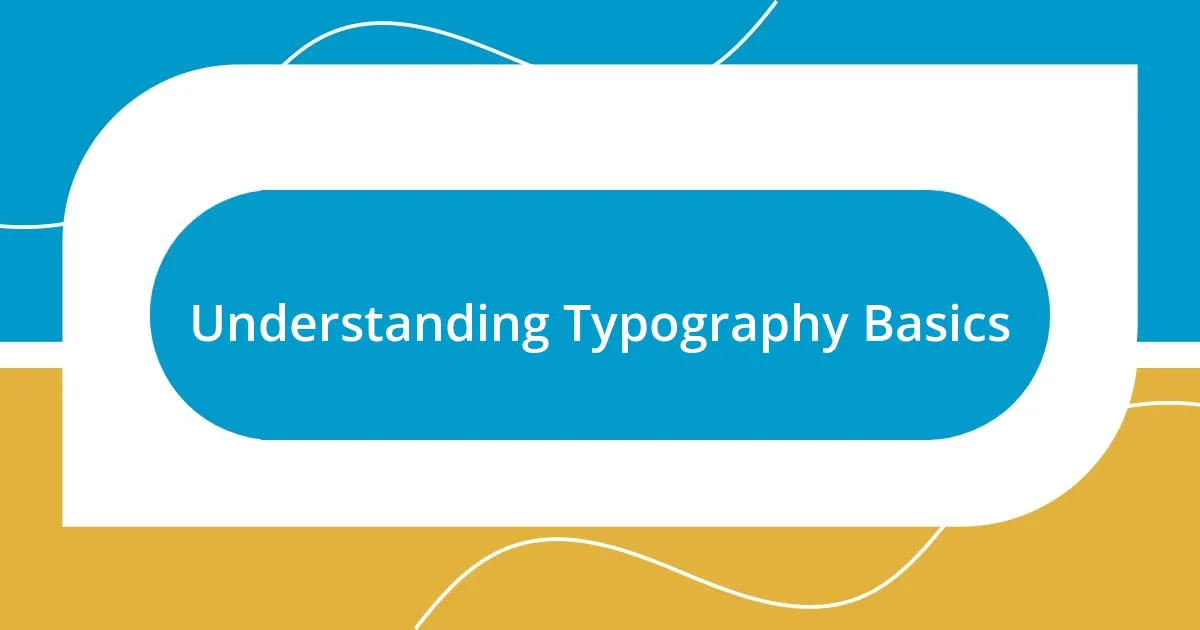
Understanding Typography Basics
When I first dove into typography, I was surprised by how much emphasis is placed on the anatomy of type. Each component, like ascenders and descenders, contributes to the overall feel of a font. Don’t you find it fascinating how a simple curve or angle can evoke different feelings and perceptions in a viewer?
During one workshop, we explored the impact of font weight and style on readability. I remember being struck by the fact that choosing the wrong typeface can alter the very message you want to convey. Have you ever stopped to consider how often you subconsciously judge a product or invitation based purely on its typography?
I’ve learned that spacing, or kerning, is just as crucial as the font itself. A few millimeters can either enhance or hinder legibility. It’s a delicate balance, and I often reflect on my own projects, realizing that even minor adjustments can lead to a more polished and inviting appearance. Isn’t it amazing how much power lies in those tiny details?
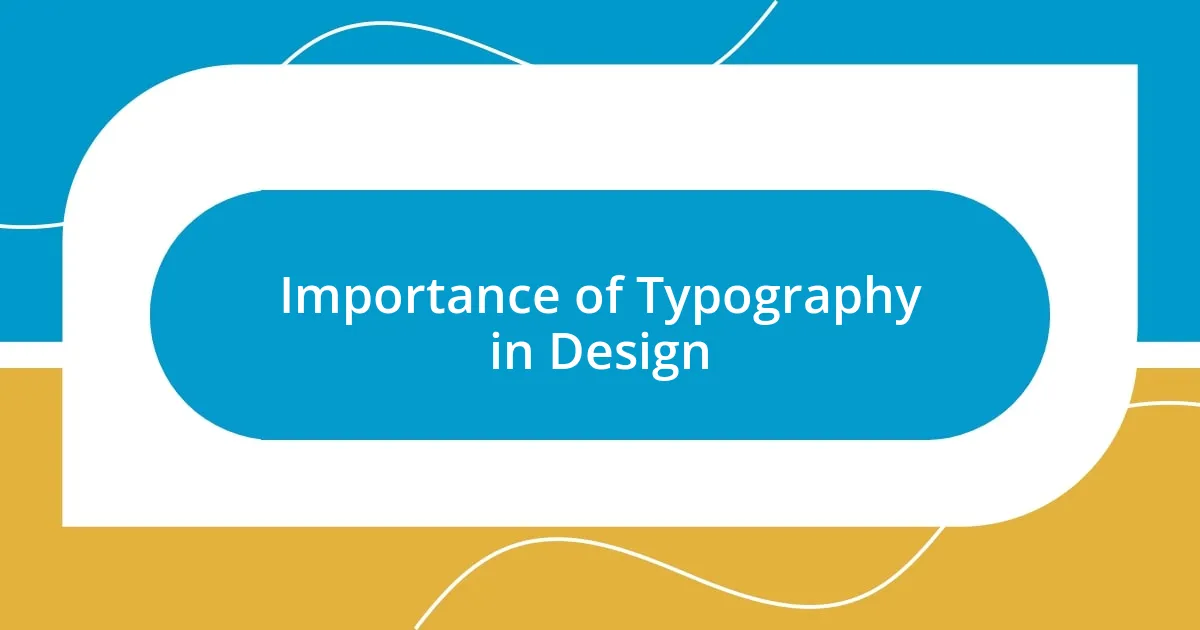
Importance of Typography in Design
Typography is more than just choosing pretty fonts; it profoundly shapes our communication. I vividly remember one workshop where we dissected how font choices affect user perception. A simple switch from a playful serif to a sleek sans-serif instantly transformed the entire vibe of a design. It made me realize that type isn’t just functional; it’s emotional.
- Effective typography enhances readability and guides the viewer’s eye.
- The right font can create trust and credibility for brands.
- Experimenting with letter spacing can vastly change the overall impact.
- Typography has the ability to evoke emotional responses, influencing audience perception undeniably.
In my own experience, when I shifted the typography in a client’s branding project, their feedback was nearly immediate. They felt a renewed sense of identity that better matched their vision—all thanks to font selection. It’s astounding how a few letters can ignite such powerful transformations in how we connect with the audience.
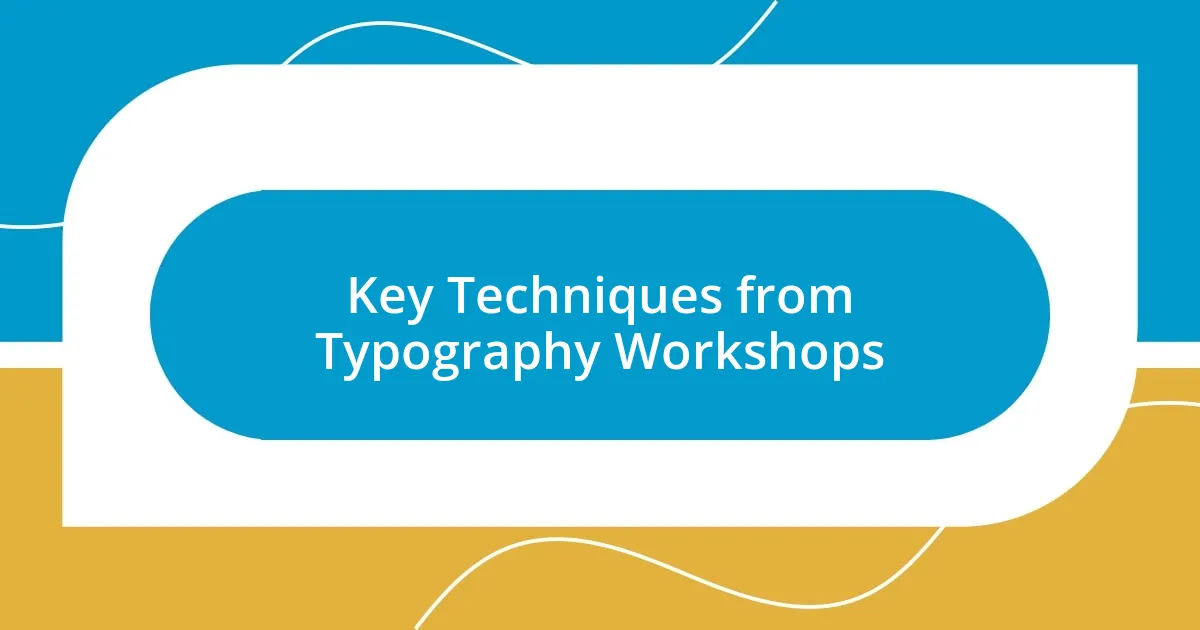
Key Techniques from Typography Workshops
One of the standout techniques I picked up in typography workshops is the power of contrast. Before diving into this journey, I often overlooked how varying font sizes and weights can create visual interest and hierarchy in a design. Now, I can’t help but notice how just a bold title paired with a light body font can guide my eyes through any layout, completely transforming the reading experience. Have you ever felt that rush when everything just clicks in design?
Another significant lesson I absorbed revolves around using grids. Grids can feel a bit rigid at first, but they provide a valuable structure for typography. I remember a particular session where we were challenged to align text within an established grid. It was enlightening how suddenly disparate elements formed a harmonious design, and it taught me that sometimes constraints can lead to greater creativity. Don’t you think it’s intriguing how a framework can liberate your artistic expression?
Finally, I learned about the necessity of consistency in typography. One instructor passionately emphasized that uniformity in type choices creates a seamless reading experience. Reflecting on my projects, I recognized that a mishmash of fonts could make designs feel chaotic. Now, I strive for a cohesive look, understanding that consistency not only enhances aesthetics but also builds brand recognition. Have you had those moments where you just knew something was off until you simplified it?
| Technique | Description |
|---|---|
| Contrast | Using differing font sizes and weights to create visual hierarchy and interest. |
| Grids | Employing a grid system for alignment, bringing structure and harmony to typography. |
| Consistency | Maintaining uniform type choices for a seamless reading experience and brand identity. |
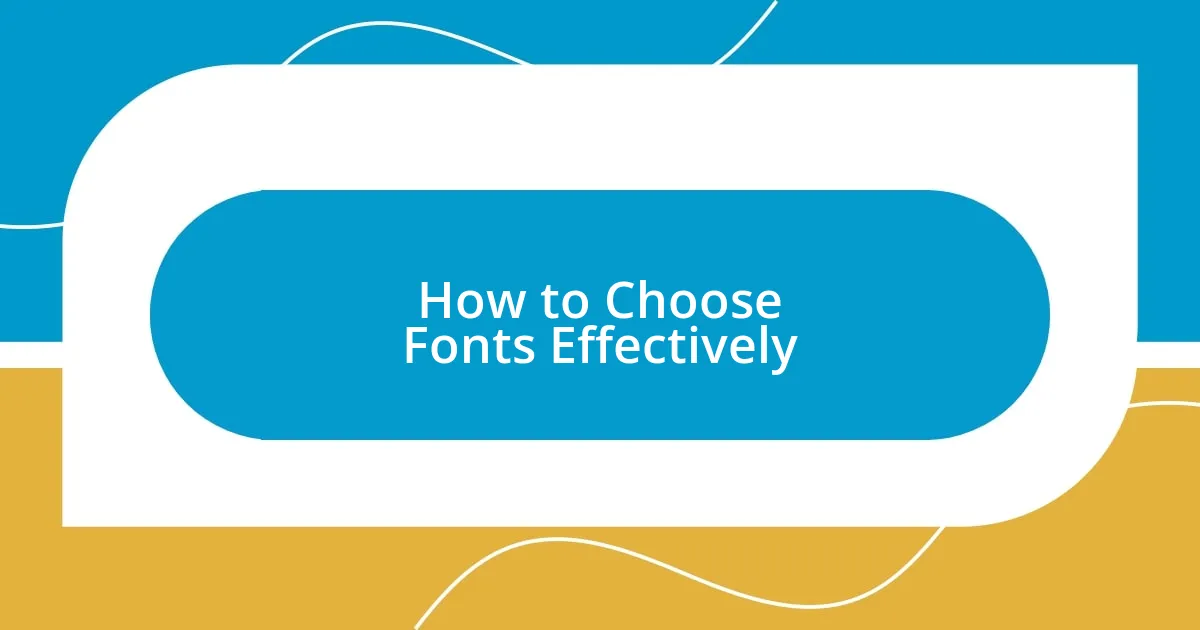
How to Choose Fonts Effectively
Choosing the right font is like finding the perfect outfit for an occasion; it has to reflect the right mood. I once received feedback on a project where I carelessly selected a whimsical font for a financial firm’s logo. Due to that choice, they felt their brand lacked the seriousness it warranted. Can you imagine how misalignment in typography can lead to such miscommunication?
When selecting fonts, consider the message and the audience. During one workshop, we dived into the psychology of typefaces—how scripts convey elegance while monospace fonts achieve clarity. Personally, I’ve found that testing a couple of fonts with real-world contexts can unveil surprising results. Have you ever tried seeing a font in action? It’s astonishing how dramatically the context influences the effectiveness of your choice.
I can’t stress enough the importance of limiting your font selections. In my early designs, I often threw in multiple fonts, convinced it added variety. But I soon discovered that simplicity married with purpose yields stronger designs. What if we focused on choosing two or three complementary fonts? It’s amazing how that can create a cohesive narrative, allowing each piece of text to breathe while telling the overall story effectively.
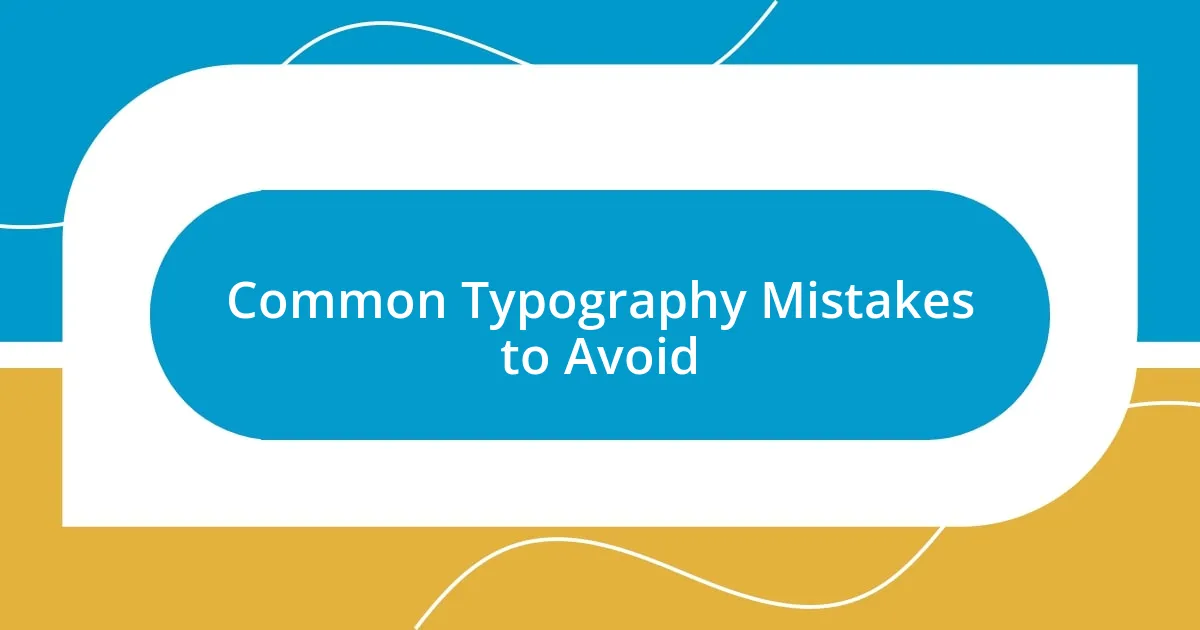
Common Typography Mistakes to Avoid
When I first started my journey into typography, one of the biggest mistakes I made was ignoring kerning and tracking. Adjusting the space between letters didn’t seem like a pivotal detail, but I quickly learned that poor spacing could lead to words feeling disconnected or even awkward. It’s fascinating how something so subtle can make or break the readability of text. Have you ever squinted at a word just because the spaces felt off?
Another common mistake I see is the overuse of decorative fonts. There’s a time and place for these embellishments, but I remember creating a poster filled with swirly fonts, thinking it would look artistic. Instead, it became legible only to me. Balancing aesthetic allure with functionality is crucial in typography, and it’s an eye-opener to understand when to hold back on the flair. Doesn’t it remind you of knowing when to dress down for a relaxed gathering rather than going all out?
Lastly, let’s chat about color contrast. In one workshop, I experimented with a light grey type on a white background, convinced it looked chic. The feedback was a slap—no one could read it! That experience taught me never to underestimate the importance of legibility. Using colors that clash poorly can leave your audience frustrated and disengaged. Have you ever found yourself straining to read something that just didn’t pop?
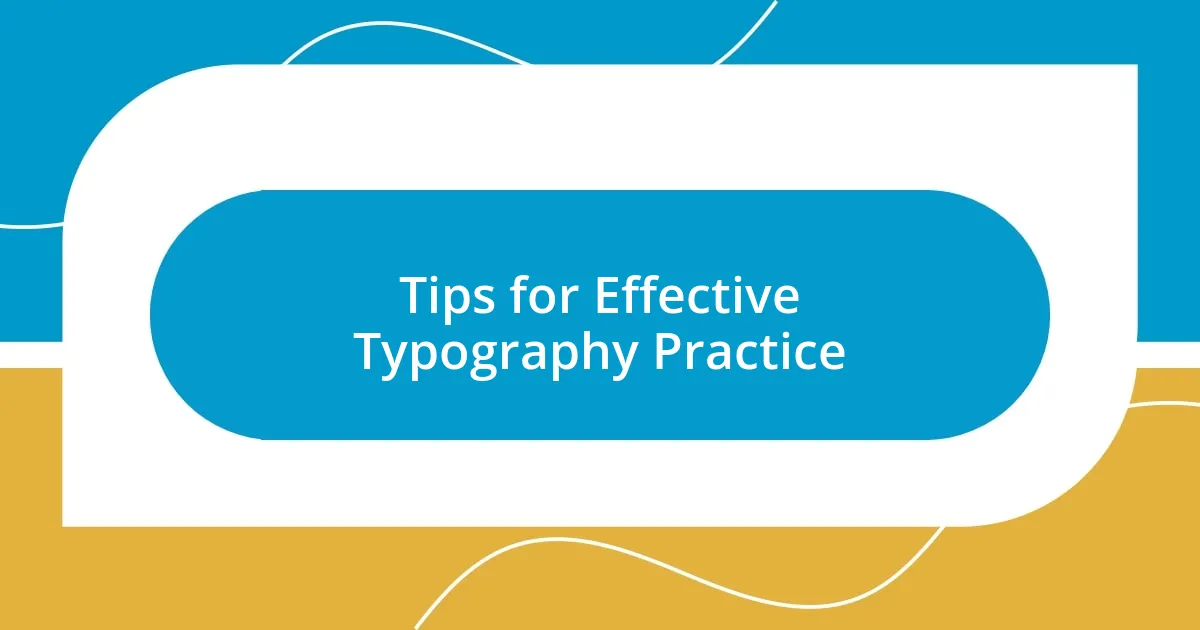
Tips for Effective Typography Practice
One key tip I’ve picked up through my typography workshops is the importance of creating hierarchy in your text. When I first started designing, I often treated all text as equal, leading to crowded visuals that were anything but inviting. It wasn’t until a mentor pointed out the power of font size and weight that I realized how impactful it could be—having a clear distinction between headings, subheadings, and body text guides the reader’s journey through the content. Have you ever noticed how your eyes naturally gravitate towards larger or bolder text? It’s all about leading your audience where you want them to go.
Another crucial aspect of effective typography practice is embracing white space. During one workshop, I witnessed a colleague’s design come to life just by giving elements more breathing room. I had always feared empty spaces, thinking they made my work look unfinished; however, now I understand that they actually enhance clarity and focus. I remember my first attempt at a poster—it felt overcrowded, and the message got lost in the chaos. Have you ever felt overwhelmed by too much information on a page? By allowing for white space, you’re not just cleaning the design; you’re also refining the message.
Finally, consistency in typography can transform a good design into a great one. When I initially experimented with different styles and sizes, it often felt disjointed. However, I learned that sticking to a defined set of fonts and styles across various projects weaves a thread of identity into your work. Something as simple as maintaining the same typeface for headers across different materials not only strengthens brand recognition but also provides a sense of familiarity for your audience. Isn’t it interesting how small adjustments can create such a unified aesthetic?

